“], “filter”: { “nextExceptions”: “img, blockquote, div”, “nextContainsExceptions”: “img, blockquote, a.btn, a.o-button”} }”>
When Sun Salutations feel good, they feel very, very good. The fluid, rhythmic sequence of postures, traditionally known as Surya Namaskar, awaken the body, focus the mind, and deepen the breath.
But that same continuous, dynamic movement that makes the sequence so exhilarating is also what makes it difficult to bring awareness—and, if needed, refinement—to its individual parts.
Perhaps there is one part of the flow that doesn’t feel so good. Perhaps you consistently drag your foot as you step forward from Adho Mukha Svanasana (Downward-Facing Dog Pose) into a lunge. Or you feel pain in your lower back when you step or jump back into Plank. Maybe your breath feels uneven or rushed during certain parts of the sequence or you’re confused as to how to make the deep breathing sounds that everyone around you is making.
There are also subtler misalignments that often go unnoticed by you and your teacher as you’re flowing.
All of these issues are more than just annoying. They prevent you from deriving the array of benefits from Sun Salutations. When you take the time to become aware of them so you can refine your approach or learn modifications that suit your body, your breath will deepen, your body will become stronger, and you’ll have a better overall experience of this series of poses.
6 common problems in Sun Salutations and how to correct them
Following are some of the most common challenges that we experience in Sun Salutations along with solutions that will help you refine the poses and find unprecedented ease in the transitions between them.
1. Lifting halfway
What often happens: It’s a small movement, lifting up from Uttanasana (Standing Forward Bend) into Ardha Uttanasana (Half Standing Forward Bend). Because it’s so subtle, there can be the tendency to rush through it by barely lifting your spine. When you give this transitional pose short shrift, you prevent yourself from experiencing its primary benefits— strengthening and decompressing the spine—and skimp on your breath. You also potentially strain your neck.
How to correct it: The key to safely practicing Ardha Uttanasana is to lift the front of your chest high enough to engage your paraspinal muscles, which are the muscles along your spine. This means that you need to lift your shoulders as high as or slightly higher than your hips. You may be able to keep your fingertips on the mat while you lengthen your spine, but most of us need to place our hands on our shins or on blocks.
From Uttanasana, start to inhale as you place your hands or fingertips on your ships and lightly press into them. Lift your torso until your shoulders are level with your hips. Press the tops of your thighs back, lengthen your spine forward, and broaden your chest while looking down and creating length along all sides of your neck. Feel your spinal muscles engage and complete your inhalation before releasing into Uttanasana.
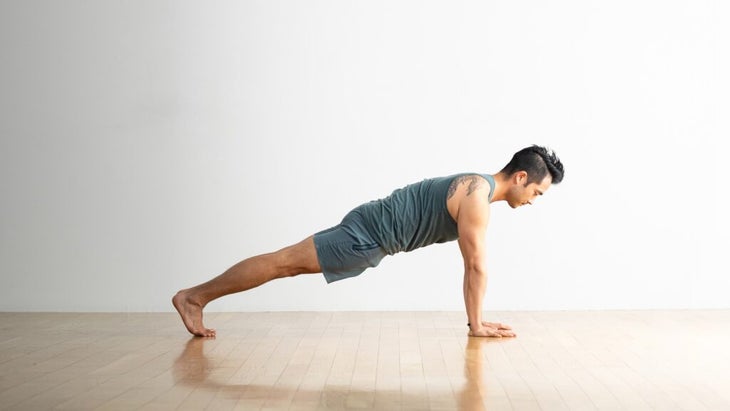
2. Finding steadiness in Plank Pose
What often happens: This pose requires a considerable amount of coordination to engage all the necessary muscles that help you find stability and steadiness. Two things can help you evenly distribute the effort throughout your entire body: adequately engaging your core and stabilizing your shoulder blades. When your Plank Pose is unsteady, you strain your wrists and your lower back.
How to correct it: Sometimes a simple tweak to your alignment is all that’s needed. Plank Pose is typically taught with the arms and shoulders stacked directly over the wrists. While this is one correct way of doing the posture, placing the hands a couple of inches in front of the shoulders can make it easier to engage the muscles on the outer borders of the shoulder blades and to pull your shoulders away from your ears, which keeps your neck long and less likely to experience tension. It also requires you to work your core more intensely. Try it and see if you experience more stability.
Come into Plank Pose with your shoulders above your wrists. Shift your feet back another 2 to 3 inches so that your hands are slightly in front of your shoulders. Press down through the base of your fingers, especially your index fingers. Broaden your shoulder blades and draw your shoulders away from your ears. Feel how these actions activate your arms and upper back. Gently draw your front ribs and the bottom of your sternum away from the mat. This subtle action engages the upper abdomen. Complement these actions by pulling the front of your hips away from the tops of your thighs.

3. Stepping your foot forward between your hands
What often happens: It can be a struggle to step your foot all the way between your hands when you transition from Downward-Facing Dog to a lunge or Warrior 1. If you can’t get your foot forward far enough, you’ll end up in a pose that flexes the knee too deeply, prevents the hip flexors from getting stretched, and makes it more difficult to step your second foot forward into Uttanasana.
How to correct it: By adding a slight modification to this transition, you’ll find an easier way to come into alignment. If you find it difficult to bring your foot all the way between your hands from Downward-Facing Dog, bring your knees onto the floor for a moment first. This may feel cumbersome, but it will help you align the front foot. With practice, you’ll be able to bring your knees down without missing a breath or falling behind. This can prevent stress on your knee and provide a stretch in your back hip flexor.
From Downward-Facing Dog, take a slow, deep inhalation. As you begin your exhalation, bring both of your knees to the floor so that you are on all fours. As you finish your exhalation, lean slightly to your left, hold on to your right ankle with your right hand, and use your hand to scooch or step your foot forward. Bring your right fingertips back to the floor next to your right foot. As you inhale, straighten your back knee and come into your lunge or Warrior Pose.
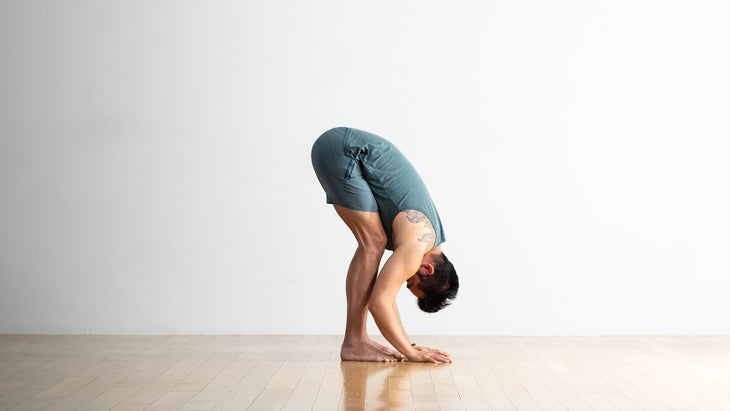
4. Jumping forward
What often happens: Jumping forward from Downward-Facing Dog to a pristine Uttanasana (Standing Forward Bend) with your feet perfectly placed between your hands can be a beautiful thing. But it’s not a necessary thing. Most people can’t jump all the way to their hands. (If you can easily press your chest against your legs in a standing or seated forward bend, you’re a candidate.) If you try to jump farther forward than your body can accommodate, you place unnecessary tension on your upper back and neck.
How to correct it: If you can smoothly jump between your hands from Downward-Facing Dog, there’s no need to stop! But if your jump lands short of your hands, there’s no reason to think that something is wrong—or that there’s a bigger benefit to landing between the hands. Your landing zone depends on the flexibility of your hamstrings. If your hamstrings are not flexible enough yet to accommodate that jump, allow yourself to land shy of your hands. If you overexert yourself in trying to jump all the way to the front, chances are you’ll overwork your shoulders and neck.
From Downward-Facing Dog, bend your knees and bring your gaze forward. Keep your eyes steadily focused on where you want to land. Wait until your exhalation is nearly complete before you take flight. If you jump during your inhalation or at the beginning of your exhalation, your midsection will be more inflated from breath, which makes it more difficult to travel forward. Jump only as far forward as is reasonable for your body, and let go of the notion that you have to land in any particular spot.
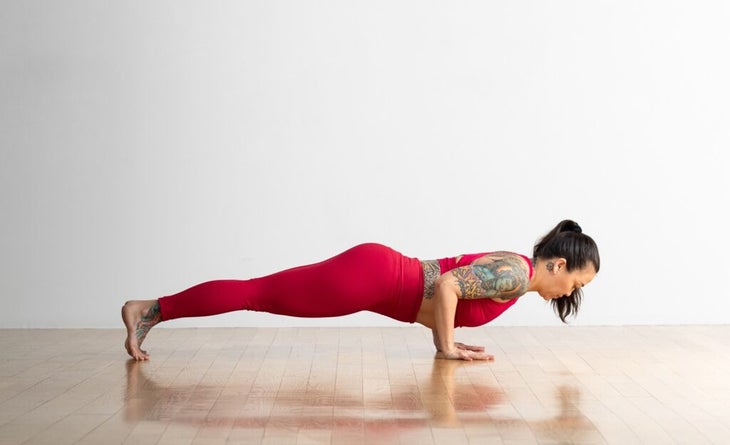
5. Jumping back to Chaturanga Dandasana
What often happens: The phrase “jumping back” is a common and apt description of taking flight as you move from Uttanasana to Chaturanga Dandasana (Four-Limbed Staff Pose). But when you take these words too literally, it can create problems. If you throw all your body weight back, you’ll arrive in Chaturanga with your hands too far forward. This misaligns your upper body, overloads your shoulders, and compresses your lower back.
How to correct it: To land in a well-aligned Chaturanga, the force of your legs moving back needs to be balanced by your chest moving forward. This requires not only abdominal strength but also body awareness, which you’ll build over time as you practice. Once you’re able to master it, the transition will feel lighter, smoother, and more graceful—even though it requires more strength.
From Uttanasana, bend your knees, place your palms on the floor, and lean slightly forward. Gaze forward so that your attention is focused on the floor in front of you. Now bend your elbows more deeply and shoot your chest forward as you jump back. As you bring your chest forward and take flight, engage your abdominal muscles, and hug your elbows toward your ribs as you bend them. Be sure to jump on the exhalation so that it’s easier to engage your abdominals. It may take a few repetitions to get the hang of it.
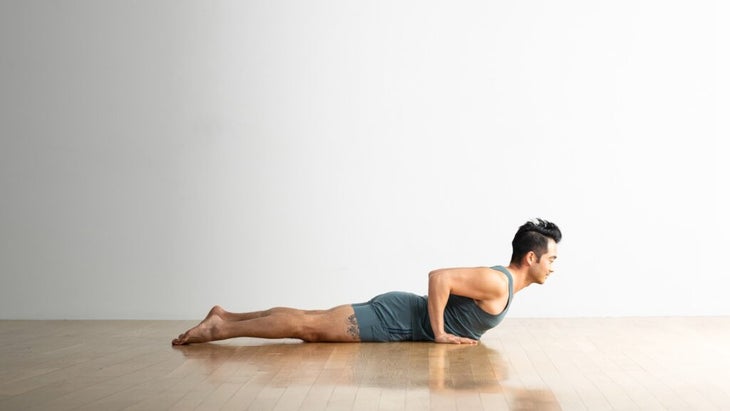
6. Not enough strength for Chaturanga Dandasana
What often happens: Chaturanga’s complex alignment makes it one of the most difficult poses in yoga. If you don’t have the sufficient upper body strength, it’s challening to find proper alignment in the posture, which can lead to shoulder, wrist, and lower-back strain and injury. Paradoxically, if you don’t have enough strength to do Chaturanga accurately, the posture loses its ability to generate strength.
How to correct it: There are many ways to modify Chaturanga Dandasana. One solution that can help you build strength while staying in the flow is to bring your knees to the floor and instead take either Bhujangasana (Cobra Pose) or Salabhasana (Locust Pose). That means while your neighbors hover in Chaturanga, you are in a different pose, and there’s nothing wrong with that. Bhujangasana strengthens part of the rotator cuff and the shoulders, arms, and chest. Salabhasana, when practiced with your palms facing the floor, strengthens the external rotators of the arms and the upper back. These postures are accessible yet demanding and can bring a strongly aligned Chaturanga within reach. Alternate between these two poses to build balanced strength.
For Cobra Pose, come onto your belly. Place your palms on the floor, with your fingertips in line with the middle of your chest. Press down through your hands, hug your elbows toward your ribs, and lift your chest. Extend your spine a moderate amount, but be sure to keep your elbows bent and squeezed in toward the sides of your body. Keep your shoulder blades firm against the back of your ribs and keep your gaze slightly forward and down to maintain the natural curve of your neck.
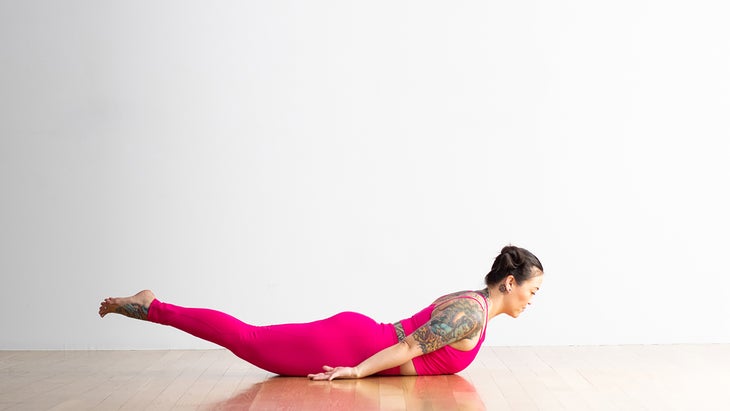
For Locust Pose, come onto your belly. Stretch your arms alongside your body and turn your palms toward the floor. Gently press down through the tops of your feet and pubic bone. (Start by keeping your feet on the floor in this version.) Lift your head, chest, shoulders, and arms off the floor as high as you can. Pull your shoulders away from your ears, and feel your upper back and arms engage. Keep your gaze slightly forward and down to maintain the natural curve of your neck. Exhale, lower back to the floor, and continue your Sun Salutation.
This article has been updated. Originally published June 20, 2013.
About our contributor
Jason Crandell lives in San Francisco and teaches alignment-based vinyasa yoga workshops around the world.

